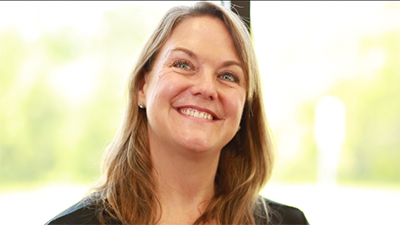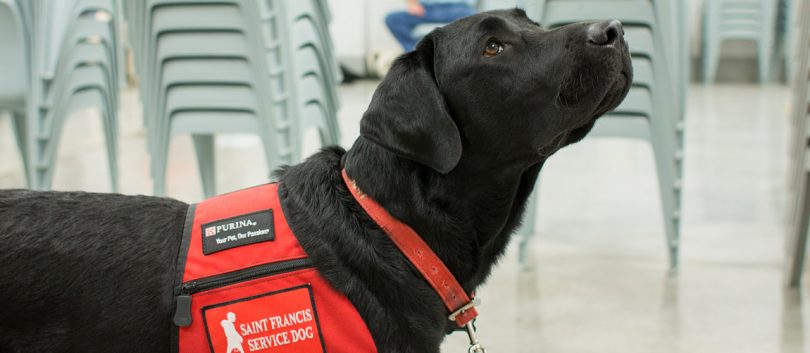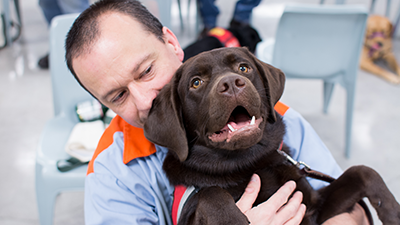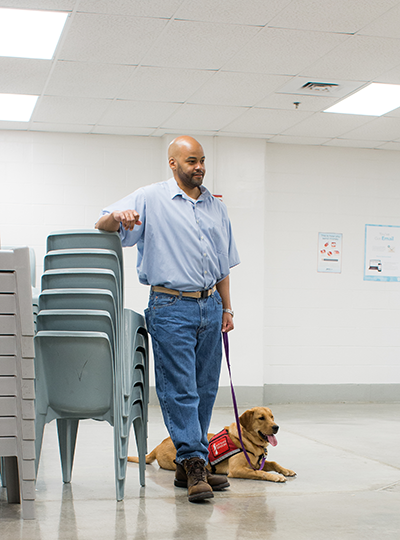Four jet black Labrador retrievers in red collars chase a red ball across a patch of freshly mowed grass. Connie Kniseley, their trainer, calls out to them. “Puppies! Puppies!” she exclaims, clapping her hands. One of the young dogs returns with the ball, tail rapidly wagging. She rubs the dog’s head. “Good girl,” Kniseley annunciates, dislodging the ball from the puppy’s jaws. She whips the ball across the lawn and the four puppies dash towards it again.
“Out here, this is socialization,” she explains, gesturing with an open hand outlining the length of a busy Interstate 81 behind Saint Francis Service Dogs Foundation. “In prison, [the dogs] don’t hear cars.”
In prison?
Since 2002, Saint Francis has maintained a partnership with the Bland Correctional Center in Bland, Virginia, a little over an hour away from the Foundation’s Roanoke, Virginia, facility. There 24 inmates help with the training and socialization of the dogs over much of their first two years of development. The program, called the PUPS program, carefully screens inmates to match with puppies. The puppies live with the inmates at the correctional facility and are raised and obedience-trained under strict guidelines. Once trained, the puppies are transferred back to Saint Francis where they complete additional training and socialization before being partnered with an applicant.
It’s a program that Bland and Saint Francis take great pride in.
“We work with men in the prison’s honor dorm,” tells Cabell Youell, executive director at Saint Francis. “The men selected to be in our program are the best of the best. They have a cell and they have a puppy who lives with them and they raise the puppy according to our protocol. One of our trainers goes in once a week to check on them. It has turned out far better than we ever expected. The dogs love prison because they get to be with their person all the time.”
According to Youell, the program isn’t the first of its kind, but the only one in the Commonwealth of Virginia.
“The first program of its type was started by a nun in Washington state—Sister Pauline. It was successful and grew from that. It’s being used more now. The prisons really like it,” she says.
For men to participate in the program at Bland, they have to already live in the honor dorm where the inmates with the best behavior live. Then they can apply and their acceptance is left to the discretion of the prison’s administration. Another prerequisite is that the men can have no history of domestic or animal abuse. They enter the program as an alternate, helping other men with their dogs, before receiving their own. Once they learn the program and commit to adhering to the training guidelines set by Saint Francis, they get their own puppy.
“Many of the men in the program train lots of dogs for us which is very helpful. And they really enjoy being part of the program because for them it’s an opportunity to do something worthwhile and it’s an opportunity to send something back into society that’s good and positive and makes an impact. I think for a lot of these men the hardest part about being in prison is that they don’t have the opportunity to help. Their efforts and their time are for naught and so through this program they actually have a positive impact on the world and they appreciate that opportunity,” says Youell.
The Nicest Men You’ll Ever Meet
Inside of Bland Correctional Center, Kniseley addresses the 19 men in the PUPS program who are meeting with her for their weekly training session. They’re seated in gray plastic chairs, attentive to the instruction of Kniseley. She has a pair of facing chairs set up on the far side of the room as a training exercise for the dogs. A few of the men, like Michael Shepperson, are weaving their dogs through the chairs. His dog isn’t having a lot of success with the exercise. Kniseley encourages him to work on getting the dog to walk around a single chair. Shepperson is raising a 9-month-old dog that he named Zelda.
“I named her after the video game for Nintendo. It was either going to be Zelda or Sonic. So I went with Zelda since it’s a girl,” he says.
Shepperson has been in the program for a year-and-a-half and says that he likes the program because it allows him to give back to the community.
“Since I’ve been in the department of corrections, I’ve had a lot of jobs [where] I’m trying to help and give back. I know this will give back to the community—and someone in particular,” says Shepperson.
Edward Taylor, who has been in the program for two years and who is now raising a 13-month-old chocolate lab named Kojak, echoes Shepperson’s sentiments.
“I’ve been at this institution since 2008 and I’ve worked at the law library for 4-1/2 years. I’ve always enjoyed interacting with the dogs and I knew a lot of the guys in the dog program. For me, it came time for a change of pace from the law library and the only really attractive job on the compound was working with the dogs,” shares Taylor. “I get something out of working with the dogs, but for me it’s always been what the dog represents. When you look at Saint Francis and their newsletters and you see the people that they’re partnered with…and the comfort that the dog brings. I enjoy having the comfort of the dog and interacting with the dog, but for me it’s the outcome; who it’s going to bless.”
At around 3 p.m., Taylor’s dog is taken off the premises for a veterinary appointment to get his leptospirosis and lyme shots, leaving him without Kojak for one week. Taylor welcomes the break and says he’ll just split time working with Chance, the 7-month-old dog of one of the other men in the program. “You miss them,” he says, “but you still have the other dogs around. We interact with each other and each other’s dog. It’s good. It’s like any other profession or job, it’s good to get away every now and then.”
And one of the perks of the job is how it affects the men on a heart level. Each cites that the dogs have influenced their lives, giving them something to care for beyond themselves and they love being able to give back to a society that they have taken something from.
Kurt Purdue, who is raising a yellow Labrador named Gina says, “This gives us a chance to give something back to the people outside; to the people who need it. It’s a blessing. That’s what it is. It makes me feel lucky and blessed. For me, and a lot of people like me, we took so much [from others] out there that when we can get our head straight and give something back to society it makes you feel good. It warms your heart.”
George Anthony Hardy, who is raising a dog he named Moses, says, “Working with the dogs teaches you to keep your mind on positive things. It makes you feel good about yourself knowing you can give something back to the community.” He hopes that Moses can live up to his namesake and lead his future partner. “I named him Moses because he was a great leader. I thought maybe it may be a good name for a dog; to be able to help people and lead them, and help them through the things that need to be done.”
The Making of a Service Dog
Dogs come to Saint Francis by way of breeders in Virginia and North Carolina. Youell says that Labrador Retrievers typically make the best service dogs because of the natural mechanism within them to retrieve objects. Most puppies are donated to the program.
“We are very fortunate that there are several reputable breeders around Virginia and North Carolina.” Youell says. “We are also a member of a cooperative which is a group of other service dog organizations across the country. That has been a good source for us because those dogs are bred to be service and therapy dogs.”
When asked whether or not dogs from shelters like the SPCA are considered, Youell says, “We keep an eye on rescues and shelters. We’re big believers in the rescue organizations, but we have to get them early enough. If not, they have fears that keep them from qualifying. They have to be exposed to sounds, touch and people. The problem with shelter dogs is that they don’t get that training early enough and they have fears that they can’t overcome, like thunder. Our dogs have to be unflappable. But we do get shelter dogs who are unafraid and they turn out to be some of our best ones”
Once in the Saint Francis network, the dogs spend time between basic training at Bland and developing advanced training on a schedule.
“We have a kennel manager on site who lives here,” says Youell. “He starts at 5:30 a.m. The dogs run, get fed, get their kennels cleaned and get exercise by 8:30 a.m. Then trainers come in and start working with the dogs. They work with them on everything from retrieving items, opening doors, bumping things, turning lights on and off and getting help.”
The trainers, who come weekly, push the dogs through this battery of tests to ensure that they will be serviceable dogs. Some will graduate and receive a partner while others will not.
“All of our dogs have to undergo a pretty rigorous health review, so we need to make sure the dogs we are going to place have a good heart, good hips, good joints, good eyes, so we evaluate all of that. If they show a high likelihood of developing hip dysplasia for example, then we’re going to dismiss that dog from the program,” says Youell.
And the dogs who don’t meet the requirements or who have health issues that disqualify them from service?
“We call those dogs career change dogs. We have a long list of people who want those dogs. They apply for them. They’re screened. A home visit is done. There is a probationary period where we make sure its a good fit for the family and the dog. And ironically those dogs cost $1,000. Our service dogs are free, but there is a charge for our career change dogs.” she says.
Other disqualifying characteristics outside of physical health issues include developmental and behavioral issues, like fear of lightning or men in hats. Youell says the dogs have to be unflappable with the ability to work under great stress.
In a work room next to her office, Youell has two large white boards that are sectioned off like spreadsheets. One of the boards lists the dogs that are at Bland, complete with their ages, photos and which inmate they’re being trained by. The other board displays a listing of dogs by name, who their trainers are and who they’re partnered with. Those are the graduate dogs.
Two of the dogs that have successfully completed the program at Saint Francis, Lincoln and Elvis, work in the legal system. They’re in a position of privilege. They sit in on forensic interviews to help victims and witnesses. Part of their training coaches the dogs to withstand a great deal of emotional trauma given the work they do. One of the other dogs on the board, Ekko, works at Riverside Rehabilitation Institute in Newport News, Virginia, in therapy and rehabilitation. In fact, in another room within the facility, there is a treadmill where dogs like Ekko learn how to use the machine for the benefit of their future patients.
“The dogs are professionally trained to do their tasks repeatedly and dependably. Our dogs who are paired with autistic partners are trained to play therapeutic games to pull them out of their shells,” Youell says. “They all have work goals.”
On a bookcase below the board are several thick binders. Within each binder is the complete story of the dog.
“Every dogs has a binder that maintains their records,” she says. “We have their breeder information, all communication, contracts, vet information, training information, et cetera.”
Helping Hands
Since Saint Francis is a small operation, they rely on the help of not just the men at Bland Correctional Center, but people in the community as well.
Volunteer coordinator Ryan Read is tasked with ensuring that the facility has plenty of volunteer power from staffing events to ensuring the availability of puppy sitters—people in the community who dog sit and help with socialization between prison visits.
“We have a need for volunteers here. My job is to meet with each of the staff to make sure their needs are met for their events.
“On Monday, we have a candidate class [for those applicants looking to be paired with a service dog]. We have volunteers who make the lunches for those classes. Every day I get a couple of people who contact me looking to volunteer,” he says.
Carol Downey is a volunteer with Saint Francis. Aside from being a major program donor with her husband, William, Downey donates her time to fundraising.
“We have developed a team here in the area who have held two “friendraisers” to help raise money to train more dogs. No organization can survive without money. People assume because a nonprofit is successful, we don’t need them anymore. At an organization like Saint Francis, we always need the financial support. We can’t train more dogs without support,” she says, also adding how having a trained service dog adds to the quality of life of its partner.
Since the dogs cost the partners nothing though program, Saint Francis relies on volunteers like Downey to help spread awareness and community support to help foot the $25,000 per dog training cost. It’s because of the amount of attention, training and effort that goes in to raising each dog that Saint Francis practices a careful, yet rigorous screening process.
Partnering Up

Saint Francis Executive Director Cabell Youell
According to Youell, there is a wait list for service dogs. Saint Francis screens 20 applicants per year and they have to meet stringent requirements in order to receive a dog.
“If someone is interested in a service dog, the first step is that they fill out a contact information form on our website, which basically holds their place in the line. When we’re accepting applications we invite those people to apply in the order in which they’ve sent us in that form. The reason for that is that we cap our waiting list at 20 people. We’re placing 10-15 dogs per year and we don’t want people waiting too long,” she says, citing the desire of Saint Francis to meet the demand in a reasonable length of time.
Once those from the web pool are selected, they are invited to apply for a dog. They receive an in-depth questionnaire, they submit medical records, a recommendation letter and meet certain requirements like having a fenced-in yard and have no other dogs unless the dogs are service dogs or older dogs. They then are assigned to a screening committee made of community health care professionals. They take on the applicant, evaluate their homes, vet their support system and all written reports and findings are discussed at a screening committee meeting.
“If the applicants are accepted, then they become a candidate. They come to Roanoke where they attend an orientation session and they attend candidate class. That’s an opportunity for them to learn the basics of how we train the dogs—socialization, manners obedience, health, grooming, exercise and games. It’s also a chance for them to meet and interact with our dogs,” explains Youell.
From there, the trainers select a few of the dogs to match with a few of the newly minted candidates based on the needs of the candidate and the ability of the dog to complement the partner.
“It’s like an arranged marriage,” jokes Youell.
Once paired, the candidate comes to Roanoke for 10 days for an intensive crash course on handling the dog and the dog goes home with them. A trainer continues to visit and follow up weekly to help with the transition. They go with the partner to church, to work, to the store or where ever they need to go to help build their confidence.
The visits then go to monthly, then annually and finally the ownership is transferred.
It Ends with Companionship
One of the best by-products of having a service dog is the companionship. Youell recalls a story she heard of a family who had a wheelchair-bound daughter and how having a dog changed her life.
“We paired a dog with a woman who lives in Christiansburg. She is in an electric wheelchair. Her parents would eat with her, say goodbye and go to work. One day the batteries died in her chair and she was stuck at the breakfast table. She couldn’t move, go to the bathroom or eat. No one knew. Her parents found her still there when they got home. They got her a dog. Now she can ask her dog to tug her a short distance to plug in her chair, ask him to get her things. She now has options and she is not alone. It helps her parents now to rest easy, but it also gives her more confidence.
“It’s very rewarding to watch these dogs change people’s lives. It’s rewarding in so many different ways than I expected. What I’ve come to realize that’s even more incredible is what these teams are able to do together. The bond they create and how they engage again in society and how they come alive during these partnerships,” says Youell. “That’s the part that speaks to me.”





